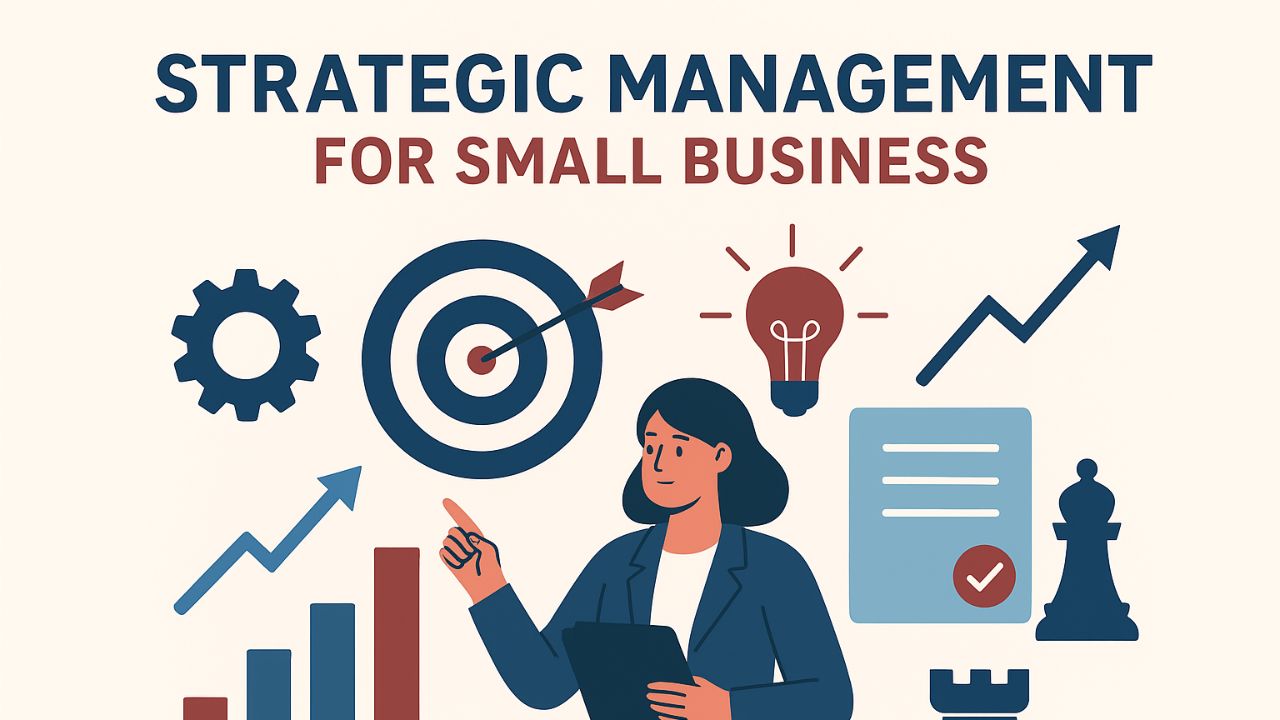
Strategic Management for Small Business: A Complete Guide to Growth and Success
Introduction (Strategic Management for Small Business)
Running a small business is challenging. Small business owners often juggle multiple roles—from operations and finance to marketing and HR. Without a clear plan, businesses can struggle with slow growth, inefficient processes, and missed opportunities.
This is where strategic management for small business becomes essential. By applying strategic principles, small businesses can set clear goals, make informed decisions, allocate resources effectively, and achieve sustainable growth.
In this guide, we’ll explore everything small businesses need to know about strategic management, step by step, and how 3EA can help you implement these strategies for measurable success.
What is Strategic Management?
Strategic management is the process of defining a business’s goals, analyzing internal and external environments, developing strategies, and implementing them to achieve long-term objectives.
For small businesses, it’s not just about planning—it’s about creating a roadmap to success while minimizing risks and maximizing resources.
Key aspects include:
Goal Setting: Identifying short-term and long-term objectives
Environmental Analysis: Understanding market trends and competitors
Strategy Development: Creating actionable plans for growth
Implementation: Executing strategies efficiently
Monitoring & Adjustment: Tracking performance and refining plans
Why Small Businesses Need Strategic Management
Small businesses face unique challenges that make strategic management critical:
Limited Resources: Small businesses often have fewer staff, lower budgets, and restricted access to technology. Strategic management helps prioritize resources effectively.
High Competition: Competing against larger businesses requires smart strategies to differentiate products and services.
Changing Market Trends: Consumer behavior and technology evolve rapidly. Businesses need to adapt quickly to stay relevant.
Operational Challenges: Streamlining processes and improving efficiency is key to maintaining profitability.
Risk Mitigation: Strategic planning helps small businesses anticipate risks and prepare contingency plans.
In short, strategic management helps small businesses survive, compete, and grow sustainably.
Core Components of Strategic Management
Strategic management involves several components that work together to ensure success:
1. Vision and Mission Statements
Vision Statement: A clear, inspiring long-term goal for your business.
Mission Statement: Defines your business purpose, target market, and core values.
Having clear vision and mission statements ensures that all business activities align with your goals.
2. Internal Analysis
Assess your business’s internal strengths and weaknesses. Common tools include:
SWOT Analysis (Strengths, Weaknesses, Opportunities, Threats)
Resource Analysis: Evaluate staff skills, technology, finances
Process Audit: Check workflows, operational efficiency, and customer service
3. External Analysis
Understand your business environment to identify opportunities and threats:
Market Trends: Study consumer behavior and emerging trends
Competitor Analysis: Identify competitors’ strengths and weaknesses
Industry Landscape: Recognize regulations, economic shifts, and technological changes
4. Strategy Formulation
Develop strategies based on your internal and external analysis:
Growth Strategies: Expand product lines, enter new markets
Cost Leadership: Reduce costs while maintaining quality
Differentiation: Offer unique products or services that competitors cannot easily replicate
5. Strategy Implementation
Execution is crucial. Without proper implementation, even the best strategies fail.
Assign clear roles and responsibilities
Allocate resources efficiently
Set timelines and milestones
Communicate strategies clearly to all team members
6. Performance Monitoring
Track key performance indicators (KPIs) to measure progress:
Revenue growth
Profit margins
Customer acquisition and retention
Operational efficiency
Regular monitoring allows small businesses to adjust strategies in real-time, ensuring sustainable growth.
Strategic Management Models for Small Businesses
Several models can help small businesses implement strategic management effectively:
1. SWOT Analysis
Strengths: Internal capabilities that give your business an advantage
Weaknesses: Areas that need improvement
Opportunities: External chances to grow or expand
Threats: External challenges that may impact your business
2. Porter’s Five Forces
Analyzes industry competitiveness through:
Threat of new entrants
Bargaining power of suppliers
Bargaining power of customers
Threat of substitute products
Competitive rivalry
3. Balanced Scorecard
Focuses on four perspectives:
Financial performance
Customer satisfaction
Internal processes
Learning and growth
Benefits of Strategic Management for Small Businesses
Improved Decision-Making: Data-driven strategies reduce guesswork.
Enhanced Operational Efficiency: Streamlined processes save time and costs.
Increased Profitability: Focus on high-value activities and revenue streams.
Competitive Advantage: Unique strategies help stand out in the market.
Sustainable Growth: Continuous planning and monitoring ensure long-term success.
Challenges in Implementing Strategic Management
Small businesses may face challenges such as:
Lack of experience in strategic planning
Resistance to change among staff
Limited budget and resources
Difficulty in monitoring KPIs effectively
Overcoming these challenges requires expert guidance, proper tools, and consistent monitoring.
How 3EA Helps Small Businesses with Strategic Management
At 3EA, we specialize in strategic management consulting for small businesses. Our services include:
Customized Strategic Planning: Tailored roadmaps for your business goals
Operational Optimization: Streamlining processes for efficiency
Financial Planning & Analysis: Cost management and profitability improvement
Marketing & Growth Strategies: Innovative approaches to attract and retain customers
Risk Management: Identifying potential risks and creating contingency plans
By partnering with 3EA, small business owners can focus on running their business while we ensure their strategic objectives are met efficiently and effectively.
Steps to Get Started with 3EA Strategic Management Services
Initial Consultation: Understand your business, goals, and challenges.
Business Analysis: Conduct SWOT and operational audits.
Strategy Development: Create actionable, measurable plans.
Implementation Support: Guide your team in executing strategies.
Performance Monitoring: Track KPIs and refine strategies as needed.
Contact 3EA today to transform your small business with a professional strategic management approach.
Conclusion
Strategic management for small business is not optional—it’s essential for survival, growth, and profitability. From setting clear goals and analyzing market trends to implementing and monitoring strategies, a structured approach can help your business thrive in a competitive landscape.
With the expert support of 3EA, small business owners can focus on what they do best, while we help them achieve long-term success through effective strategic management.
✅ Invest in strategic management today, and secure the growth of your small business tomorrow.








Stay Connected: